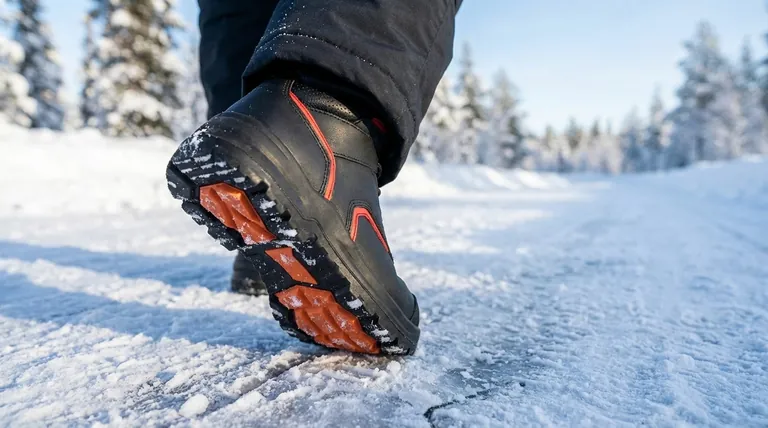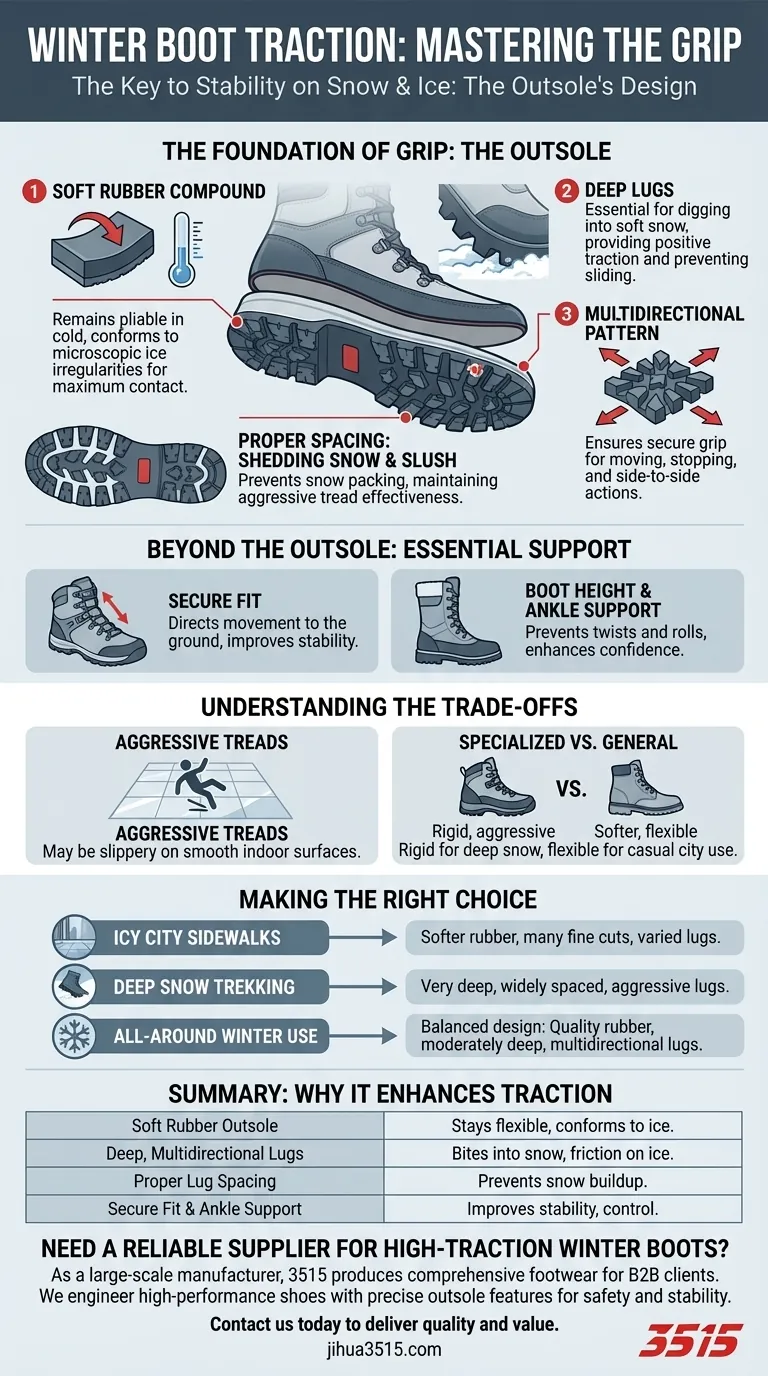The most critical features for enhancing traction in winter boots are found in the outsole, the part of the boot that contacts the ground. Superior grip comes from a specific combination of a soft rubber compound and a tread pattern with deep, multi-directional lugs.
While insulation and waterproofing provide comfort, true winter safety is determined by the outsole's design. A flexible rubber that stays soft in the cold, paired with an aggressive lug pattern, is the key to maintaining a reliable grip on unpredictable snow and ice.

The Foundation of Grip: The Outsole
The entire performance of a winter boot's traction system rests on the design and material of its outsole. This single component is engineered to navigate the unique challenges of frozen surfaces.
Why Material Matters: The Role of Rubber
The type of material used for the outsole is your first line of defense. Sturdy, high-quality rubber is the industry standard for a reason.
Unlike harder plastic compounds that can become stiff and slick in freezing temperatures, good rubber remains pliable. This flexibility allows the sole to conform to microscopic irregularities in ice and packed snow, maximizing surface contact and grip.
The Anatomy of Tread: Deep and Multidirectional Lugs
The pattern of the tread, known as the lug pattern, is what provides mechanical grip. It's designed to bite into soft surfaces and create friction on hard ones.
Look for deep lugs (the individual blocks of the tread). Deeper treads are essential for digging into snow, providing positive traction and preventing you from sliding.
Equally important are multidirectional lugs. A pattern with lugs facing various directions ensures a secure grip whether you are walking forward, stopping, or moving side-to-side on uneven terrain.
Surface Area and Spacing
The design isn't just about the lugs themselves, but also the space between them.
Proper spacing allows the outsole to shed snow and slush effectively. If lugs are too close together, they can get packed with snow, turning your aggressive tread into a smooth, slippery surface.
Beyond the Outsole: Essential Supporting Features
While the outsole provides direct grip, other aspects of the boot's construction contribute to your overall stability and safety.
The Importance of a Secure Fit
Even the best outsole is ineffective if your foot is sliding around inside the boot. A secure fit ensures that your movements are transferred directly to the ground.
An adjustable lacing system allows you to create a snug fit, which improves stability and control, reducing the chance that a minor slip becomes a serious fall.
How Boot Height Affects Stability
Taller boots that extend over the ankle provide crucial support. This added ankle stability helps prevent twists and rolls on uneven, frozen ground.
While not a direct traction feature, this support works with the outsole to keep you upright and confident in challenging conditions.
Understanding the Trade-offs
No single boot is perfect for every winter scenario. Understanding the limitations of different designs is key to making an informed choice.
Aggressive Treads vs. Indoor Surfaces
Boots with extremely deep, aggressive lugs designed for deep snow can be clumsy and even slippery on smooth indoor surfaces like tile or polished concrete.
The hard edges of the lugs make less contact with the smooth floor, reducing grip compared to a flatter sole.
Specialized vs. General-Use Boots
A boot designed for mountain climbing or deep-snow trekking will have a very rigid and aggressive sole. This is excellent for its specific purpose but may be uncomfortable and excessive for casual city walking.
Conversely, a more stylish urban winter boot might have a softer, more flexible sole that is comfortable but lacks the deep lugs needed for unplowed trails.
Making the Right Choice for Your Goal
Select your boot based on the conditions you will face most often.
- If your primary focus is walking on icy city sidewalks: Look for a softer rubber outsole with many small, fine cuts and varied lug shapes to maximize contact with hard ice.
- If your primary focus is trekking through deep snow: Prioritize boots with very deep, widely spaced, and aggressive lugs that can bite into soft snow and clear themselves easily.
- If your primary focus is all-around winter use: Seek a balanced design featuring a quality rubber compound with moderately deep, multidirectional lugs for versatility.
By inspecting the outsole for these key features, you can confidently choose a boot that provides the stability you need to stay secure all winter.
Summary Table:
| Feature | Why It Enhances Traction |
|---|---|
| Soft Rubber Outsole | Stays flexible in cold, conforming to ice and snow for better grip. |
| Deep, Multidirectional Lugs | Bite into soft snow and provide friction on ice from all angles. |
| Proper Lug Spacing | Prevents snow buildup, ensuring the tread remains effective. |
| Secure Fit & Ankle Support | Improves stability and control, transferring your movement to the ground. |
Need a reliable supplier for high-traction winter boots?
As a large-scale manufacturer, 3515 produces a comprehensive range of footwear for distributors, brand owners, and bulk clients. Our production capabilities encompass all types of high-performance shoes and boots, engineered with the precise outsole features detailed above to ensure safety and stability in winter conditions.
Contact us today to discuss your specific needs and discover how we can deliver quality and value to your business.
Visual Guide

Related Products
- Premium Wholesale Waterproof Safety Boots High Performance Protection for Industrial Markets
- Customizable Anti-Smash Safety Boots for Wholesale & Private Label Manufacturing
- Premium Grain Leather Safety Boots for Bulk Supply
- Custom Wholesale Leather Safety Boots Direct Factory Manufacturing
- High Performance Fire-Retardant Waterproof Safety Boots
People Also Ask
- What are some examples of footwear requirements in different work settings? Ensure Safety and Compliance
- What is a safety-toe in a boot? Your Guide to Choosing the Right Protection
- What are the key considerations when choosing safety boots? Match Hazards to Features for Maximum Protection
- What is the primary purpose of safety shoes? Your Ultimate Guide to Workplace Foot Protection
- How does routine boot maintenance benefit workplace safety? Proactive PPE Protection for Your Workforce



















